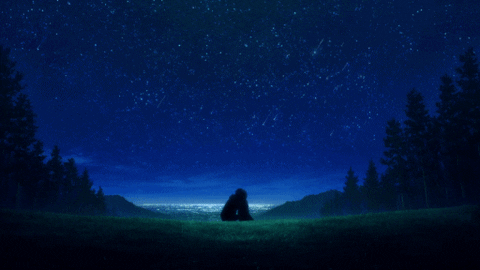One tantalizing idea about how life began on Earth is that it didn’t.
That is to say, life began somewhere else, and then it made its way to Earth by way of travel through space, arriving here already across that mystical threshold that seems to separate life from non-life.
This idea is called panspermia, and that breaks down into the ancient Greek words pan (all) and spermia (seeds).
In Ancient Greece, a philosopher named Anaxagoras presented a pretty wild idea to the world in the middle of the 4th century BCE. His idea was that the seeds of life (he called them spermata) were scattered throughout the cosmos, and further that these seeds could combine in various ways.
Anaxagoras also believed in some kind of intelligent guiding force, like a mind for the universe or an omnipotent god, called Nous. This combination ultimately determined what form of life arose, and that’s how all life got here on Earth.
While panspermia only kicks the origin of life down the line a bit further, meaning you still have to answer the question about how life arose in the first place, it’s a tantalizing idea to consider. To be clear, there is zero evidence that life arose anywhere other than on our planet, and we don’t have any good reason to believe it started elsewhere.
Still! Is the idea possible?
Let’s talk about our old friend the tardigrade for a moment. These little water-bears will shrivel up into a state called tun. In this state, their bodies replace water with a glass-like substance that protects their organs and DNA until conditions improve.
Could they have traveled through space for decades or centuries, frozen in a Han Solo-like state until the arrived across the cosmos?
It’s probably not ideal to imagine a tiny little tardigrade flying through outer space all by itself. Instead, imagine that a small creature was trapped inside of a rock, and that rock was then ejected into space through some kind of impact.
That rock could shield the little critter from cosmic radiation, which could easily destroy any semblance of life. And, even better than a tardigrade, imagine a microbial organism like the extremophiles that live at the bottom of our oceans, far removed from sunlight.
This specific subset of panspermia is called lithopanspermia, but it’s not the only type of extraterrestrial origin story. It’s also possible that microbial spermata could have traveled through space by hitching a ride on a comet or asteroid.
It might even be possible that a tiny microorganism or a virus traveled freely through the void of space, hitching a ride on some stellar winds (yes, this is a real thing that happens to tiny dust particles). Of course, we’re well over the speculation line now, and this is more in the “fun to think about” category.
Of course, little green men could have arrived and planted life on the planet several billion years ago. Or, large ghostly figures, like in the movie Prometheus:
Humble apologies if that’s a spoiler for you, but go watch Prometheus anyway.
This concept is called directed panspermia, and it’s the easiest of these ideas to dismiss or make fun of. This is the stuff of tabloid journalism and cheesy horror movies, and far too many conspiracy theorists have spun out on this, asserting that they know for sure this is how we got here.
We do know that there are extremophiles that can survive harsh conditions, maybe even deep space. We have to admit that panspermia is possible, even if it does seem incredibly improbable.
At the same time, we can point out why it’s so improbable. Even if a microorganism could survive interstellar travel—something that’s not at all entirely clear to us—we have to consider atmospheric entry. In many ways, this is the toughest hurdle for our thought experiment, as almost everything burns to a crisp and disintegrates by way of ablation.
Those tiny sparks that will create the Perseid Meteor Shower this weekend will give you a visual on just how tough this hurdle really is for life.
What’s far more provocative (for me, anyway) is that organic molecules—the building blocks of life—really are out there in the cosmos. We know that some meteorites contain amino acids, and that’s what RNA is made up of.
There’s also the increasingly prominent idea that comets and asteroids can deliver water to a planet. Is it possible that both amino acids and water were delivered from outer space, like some kind of Amazon Prime life starter kit?
The much more conventional view on how life began on our planet is called abiogenesis, and it just means that it arose without other life. I wrote about that idea a bit here:
Abiogenesis leaves plenty of room for those amino acid molecules constantly arriving on our planet, bombarding us and adding to the increasingly organic soup that made up the early Earth. It also leaves no requirement for an extraterrestrial origin for life, but that doesn’t mean panspermia isn’t super fun to consider!








I remember reading about a hybrid approach called exogenesis, which combines the ideas of abiogenesis and panspermia.
In this theory, the building blocks of life, such as organic molecules, may have been delivered to Earth via comets or meteorites; the actual development of life occurred through natural processes on Earth.
Would we ever know the answer to this question? If we can find life outside of Earth in the future, we will probably have a better theory around this topic.
As you say, the idea of panspermia kicks the can down the road...and hence is intellectually unsatisfying. It still had to have an origin somewhere. Parsimony dictates we consider the origin to be here rather than extraterrestrial; we can't prove it either way, so the most parsimonious explanation is it arose here. The famous Miller-Urey experiment shows it's unnecessary to even invoke exogenesis (https://en.wikipedia.org/wiki/Miller%E2%80%93Urey_experiment).
Interestingly, because all organisms share the same genetic code (that is, which three-nucleotide sequence codes for which amino acid) we know life on earth had only one origin point that survived to the present. This is because which three-nucleotide sequence corresponds to which amino acid is arbitrary, and it's highly unlikely all life would share that code unless we all had a single ancestor with that code.